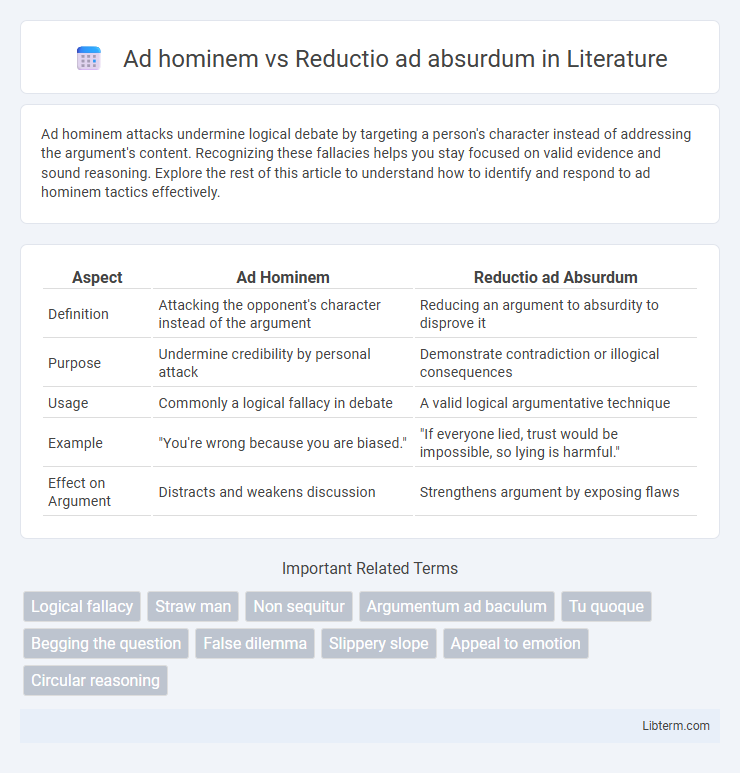Ad hominem attacks undermine logical debate by targeting a person's character instead of addressing the argument's content. Recognizing these fallacies helps you stay focused on valid evidence and sound reasoning. Explore the rest of this article to understand how to identify and respond to ad hominem tactics effectively.
Table of Comparison
| Aspect | Ad Hominem | Reductio ad Absurdum |
|---|---|---|
| Definition | Attacking the opponent's character instead of the argument | Reducing an argument to absurdity to disprove it |
| Purpose | Undermine credibility by personal attack | Demonstrate contradiction or illogical consequences |
| Usage | Commonly a logical fallacy in debate | A valid logical argumentative technique |
| Example | "You're wrong because you are biased." | "If everyone lied, trust would be impossible, so lying is harmful." |
| Effect on Argument | Distracts and weakens discussion | Strengthens argument by exposing flaws |
Understanding Ad Hominem: Definition and Origins
Ad hominem is a logical fallacy where an argument attacks a person's character or traits instead of addressing the actual issue, often diverting the discussion from the topic at hand. Originating from Latin, meaning "to the person," this fallacy undermines rational debate by shifting focus from ideas to individual characteristics. Understanding its roots and usage is essential for recognizing and avoiding emotional misdirection in critical thinking and discourse.
Reductio ad Absurdum Explained: Meaning and History
Reductio ad absurdum is a classical argumentative technique that demonstrates the falsity of a premise by showing that its logical consequence leads to an absurd or contradictory conclusion. Originating from ancient Greek philosophy and extensively utilized by Aristotle, this method aims to refute statements by exposing their implications as untenable or logically impossible. Unlike ad hominem attacks, which target the opponent's character rather than the argument, reductio ad absurdum focuses on the internal consistency of the argument itself.
Key Differences Between Ad Hominem and Reductio ad Absurdum
Ad hominem attacks target the opponent's character or personal traits instead of addressing the argument's substance, undermining the credibility of the individual rather than engaging with their claims. Reductio ad absurdum involves extending an argument to its logical extremes to demonstrate its absurdity or contradiction without attacking the person presenting it. The key difference lies in ad hominem being a fallacious personal attack, while reductio ad absurdum is a legitimate logical technique aimed at disproving a claim through illustrating its untenable consequences.
Common Examples of Ad Hominem Fallacies
Common examples of ad hominem fallacies include attacking a person's character, motives, or other attributes instead of addressing the argument itself, such as calling someone "untrustworthy" or "ignorant" to discredit their viewpoint. This type of fallacy diverts attention from the evidence and logic of the argument to personal insults or irrelevant traits. Unlike reductio ad absurdum, which aims to demonstrate absurdity by extending the argument's logic, ad hominem seeks to undermine the opponent without engaging with their actual claims.
Illustrative Cases of Reductio ad Absurdum Arguments
Reductio ad absurdum arguments are effectively illustrated in cases such as Zeno's paradoxes, where proving motion is impossible reveals contradictions in the concept of infinite divisibility. Another classic example is in mathematics, where assuming the negation of a theorem leads to an absurd or impossible result, thereby confirming the original statement's truth. These cases demonstrate the technique's power in exposing flaws by extending premises to logically untenable conclusions, contrasting with ad hominem attacks that target the arguer rather than the argument itself.
Logical Structure: How Each Argument Works
Ad hominem attacks the character or motive of a person instead of addressing the argument's substance, aiming to undermine credibility and distract from the logical content. Reductio ad absurdum demonstrates the falsity of a premise by logically extending it to an absurd or contradictory conclusion, thereby exposing flaws in the initial argument. Both rely on different logical structures: ad hominem bypasses logical evaluation by attacking the individual, while reductio ad absurdum uses rigorous logical progression to invalidate a claim.
Impact on Debates: Effectiveness and Pitfalls
Ad hominem attacks undermine debates by shifting focus from the argument to the person, weakening credibility and obstructing constructive dialogue. Reductio ad absurdum enhances debates by exposing logical inconsistencies through exaggeration, though it can mislead if oversimplified or used fallaciously. Both techniques influence persuasion and clarity, with ad hominem risking ad hominem fallacies and reductio ad absurdum demanding careful application to maintain argumentative rigor.
Recognizing Logical Fallacies in Everyday Discussions
Recognizing logical fallacies such as Ad hominem and Reductio ad absurdum enhances critical thinking in everyday discussions by identifying attacks on character instead of arguments and exaggerated conclusions that distort reasoning. Ad hominem fallacies divert attention from the actual issue by targeting the person, while reductio ad absurdum oversimplifies or mocks arguments to discredit them. Understanding these distinction aids in promoting fair, rational debates and improving communication effectiveness in personal and professional settings.
How to Respond to Ad Hominem and Reductio ad Absurdum
When responding to ad hominem attacks, maintain focus on the argument by calmly addressing the claim's validity rather than the person's character. Counter reductio ad absurdum by pointing out any misrepresentation or exaggeration of the original argument and clarifying the intended logical boundaries. Employing clear, evidence-based rebuttals minimizes the effectiveness of fallacious reasoning and fosters constructive dialogue.
Strengthening Critical Thinking: Avoiding Faulty Reasoning
Distinguishing between ad hominem attacks and reductio ad absurdum arguments is crucial for strengthening critical thinking by avoiding faulty reasoning. Ad hominem fallacies undermine rational debate by targeting the person instead of the argument, whereas reductio ad absurdum techniques expose inconsistencies by logically demonstrating absurd consequences. Mastering these concepts enhances analytical skills and ensures that conclusions are supported by valid, evidence-based reasoning.
Ad hominem Infographic

 libterm.com
libterm.com